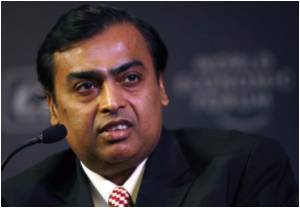
Ambani, his wife, three children and possibly his elderly mother are said to be weeks away from moving into their new home, which according to reports has six floors of parking, swimming pools, a ballroom, a cinema and three helipads.
Few people publicly begrudge 53-year-old Ambani his 29-billion-dollar fortune or his success as head of India's largest private company, Reliance Industries Limited.
But the lavish pad, which one British newspaper suggested epitomised "the swagger and confidence of India's economically buoyant upper echelons", is as real for most as the mythical island "Antilia" it is supposedly named after.
Half of the estimated 18 million people in India's crowded financial hub live in sprawling, insanitary slums, with sketchy or non-existent electricity and water supplies.
The gulf between rich and poor is visible just a short walk from Altamount Road, where entire families can be found living under a flyover and on pavements near the foreign consulates and exclusive boutiques.
Advertisement
"Goals of human development cannot be realised if the people, in this case half of the city, live in an environment which is polluted, degraded and dehumanising," it said.
Advertisement
Apartments costing upwards of four million dollars are planned for the 117-storey "World One" tower, which is due to open in 2014.
The head of leading property developers DB Realty, Shahid Balwa, told AFP recently that demand for luxury properties was sustainable and Mumbai could absorb 30,000 to 40,000 one million dollar-plus homes every year.
In contrast, the local Maharashtra Housing and Development Authority (MHADA) last year advertised 3,000 affordable homes and received 500,000 applications, said Maju Varghese, of the non-governmental organisation YUVA Urban.
"The system doesn't work for most people," added Varghese, whose group has worked with the urban poor for the last two decades.
"What has happened in Mumbai is that the urban poor and the middle classes are not in a position to get housing."
Anil Nair, executive editor at Property World magazine, said tackling the problem was on the back burner as real estate prices rebound after the economic downturn and the number of high earners increases on the back of India's boom.
"The issue with affordable housing is that margins are low. Developers usually give up affordable housing plans when there's a boom time as you can get much better returns (from more expensive properties)," he said.
The price of affordable housing in Mumbai is generally seen at about eight million rupees (180,000 dollars), Nair added.
In 2009-10, the government said that the average per capita income in India was 44,345 rupees.
As such, it is unsurprising that few people can buy property in Mumbai -- or get loans to cover the cost -- creating a scrap for low-price homes and precious parcels of land when they come onto the market.
"I've seen Gujarati ladies fighting over the fact that one booked a new flat before the other. The demand is always so high," said Nair.
The state government's approach "leaves a lot to be desired," he said, although it recently ordered developers to reserve a percentage of new flats for "economically weaker sections" of society.
But even then there are problems, said Varghese, who left the city for the commuter town of Navi Mumbai in search of lower rental and property prices.
"Poor people's houses are being amalgamated and becoming two-bedroom flats, then sold on. They might not be able to afford the maintenance charges and are pushed out. It's happening everywhere," he added.
Source-AFP






